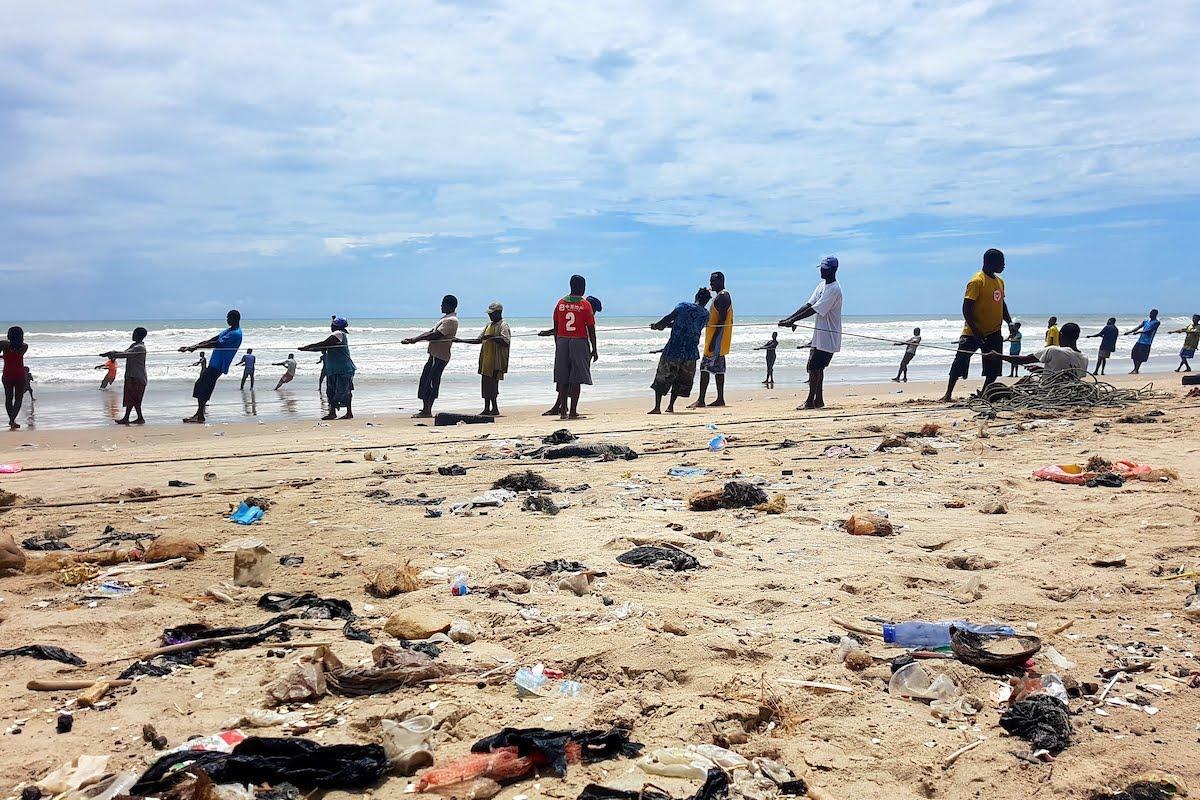Monitor, educate, motivate: How the Museum für Naturkunde Berlin is helping the African country to tackle the waste crisis.
This article was first published in our journal For Nature (issue 8/2023).
If proof were needed that the Museum für Naturkunde Berlin is an internationally active research museum, then it was easily provided in mid-September 2023 on a bridge in Ghana's capital Accra. There, museum employees Sabrina Kirschke and Lea Schmidtke are in intensive discussions with interested citizens of Accra.
Sabrina Kirschke is a political scientist and heads the accompanying social science research in the project "Community-driven freshwater plastic monitoring in Western Africa", Lea Schmidtke is a student and responsible for conducting interviews and surveys in the project. However, the view next to the two of them over the bridge parapet into the Odaw River is less pleasing. In the water and on the banks, large quantities of plastic are particularly noticeable. That's exactly why they are here.
The Republic of Ghana is facing a plastic waste crisis because there is currently no adequate infrastructure for recycling and managing plastic waste. The result is plastic waste in many parts of the city, with an impact on health and the environment. The Ghanaian government has therefore declared war on plastic entering the environment. The project is intended to help here.
By learning standardized methods of plastic observation and monitoring, the aim is to collect more data on the occurrence of plastic in rivers in the medium term and thus also raise awareness among citizens and politicians about the environmental problem of plastic and its causes and consequences. The researchers believe that this in turn will promote a willingness to actively participate in existing plastic collection campaigns or to tackle the problem preventively with suitable political measures.
However, Sabrina Kirschke and Lea Schmidtke are not doing this alone. The project, which is funded by the United Nations Environment Programme (UNEP), is backed by an international consortium of three partners. In addition to the Berlin Museum, these are Wageningen University, which is leading the project, and the Helmholtz Center for Environmental Research in Magdeburg.
"We are the social science partners in this project, the others are the monitoring experts," explains Sabrina Kirschke. "They know how to measure macroplastics and microplastics in rivers and lakes. We are helping to get the local population involved and are researching how to further optimize such citizen science projects."
Learning together: no one has a one-size-fits-all solution
The work on the bridge over the Odaw is part two of the task that Kirschke and Schmidtke are carrying out in Accra. It all began a few days earlier with a workshop for interested parties from various areas of society. During the workshop, an intensive exchange took place on the monitoring of micro- and macroplastics in flowing waters. How can the amount of microplastics and macroplastics transported by a watercourse be measured?
Which methods and equipment are suitable for these measurements, even with few resources? And most importantly for Kirschke and Schmidtke: how can citizen science be integrated here in a sustainable and long-term manner? It's about learning together. Nobody has a one-size-fits-all solution. They worked together to find the best possible solutions. What they have learned is now being put to the test on the bridge over the Odaw. For the teachers involved, for example, it turns out that it is actually easy and safe to retrieve bottles and other macroplastics from the flowing water using nets and to estimate their respective quantities in the river.
"They want to continue using these methods with their pupils in the future," says Lea Schmidtke happily. And there is even more reason to be happy. When monitoring on curious members of the public keep coming by the bridge and want to know what is happening there. The two museum employees get into conversation with many people, sometimes with their hands and feet.
The reactions to what is being done here are very positive. People very much welcome the fact that the measuring methods used here are to be passed on to the schools by the teachers. They all hope that the project will improve the situation, meaning less plastic waste in their environment in the future, a hope that Lea Schmidtke also shares, "after all, the waste that ends up in Accra also comes from Europe". In terms of raising awareness, some people may be thinking about the problem of plastic waste for the first time in their lives.
Inquiries from other African countries
A few days later, back in Berlin, Sabrina Kirschke and Lea Schmidtke take stock of their stay in Accra. It should be noted that the citizen science approaches they brought with them were seen there as an important solution strategy. Conversely, a lot was also learned in Accra that can be used for the further development of Citizen Science in Germany.
Both will also remember the very committed, unusually friendly and open people in Accra, "not least our local project partner Kwame Duah Anhwere from the TAHMO organization, without whose great support none of this would have been possible," adds Lea Schmidtke.
The success of the project can also be seen from the fact that there have been further inquiries from other African countries who also want to do something about the problem of their plastic waste.
Text: Andreas Kunkel
Picture: Andrew Gemmell, SLR Consulting
